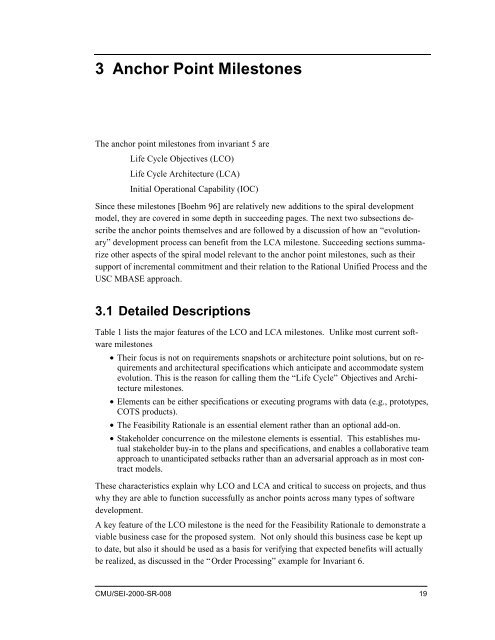00sr008
00sr008
00sr008
You also want an ePaper? Increase the reach of your titles
YUMPU automatically turns print PDFs into web optimized ePapers that Google loves.
3 Anchor Point Milestones<br />
The anchor point milestones from invariant 5 are<br />
Life Cycle Objectives (LCO)<br />
Life Cycle Architecture (LCA)<br />
Initial Operational Capability (IOC)<br />
Since these milestones [Boehm 96] are relatively new additions to the spiral development<br />
model, they are covered in some depth in succeeding pages. The next two subsections describe<br />
the anchor points themselves and are followed by a discussion of how an “evolutionary”<br />
development process can benefit from the LCA milestone. Succeeding sections summarize<br />
other aspects of the spiral model relevant to the anchor point milestones, such as their<br />
support of incremental commitment and their relation to the Rational Unified Process and the<br />
USC MBASE approach.<br />
3.1 Detailed Descriptions<br />
Table 1 lists the major features of the LCO and LCA milestones. Unlike most current software<br />
milestones<br />
•Their focus is not on requirements snapshots or architecture point solutions, but on requirements<br />
and architectural specifications which anticipate and accommodate system<br />
evolution. This is the reason for calling them the “Life Cycle” Objectives and Architecture<br />
milestones.<br />
•Elements can be either specifications or executing programs with data (e.g., prototypes,<br />
COTS products).<br />
•The Feasibility Rationale is an essential element rather than an optional add-on.<br />
•Stakeholder concurrence on the milestone elements is essential. This establishes mutual<br />
stakeholder buy-in to the plans and specifications, and enables a collaborative team<br />
approach to unanticipated setbacks rather than an adversarial approach as in most contract<br />
models.<br />
These characteristics explain why LCO and LCA and critical to success on projects, and thus<br />
why they are able to function successfully as anchor points across many types of software<br />
development.<br />
A key feature of the LCO milestone is the need for the Feasibility Rationale to demonstrate a<br />
viable business case for the proposed system. Not only should this business case be kept up<br />
to date, but also it should be used as a basis for verifying that expected benefits will actually<br />
be realized, as discussed in the “Order Processing” example for Invariant 6.<br />
CMU/SEI-2000-SR-008 19














